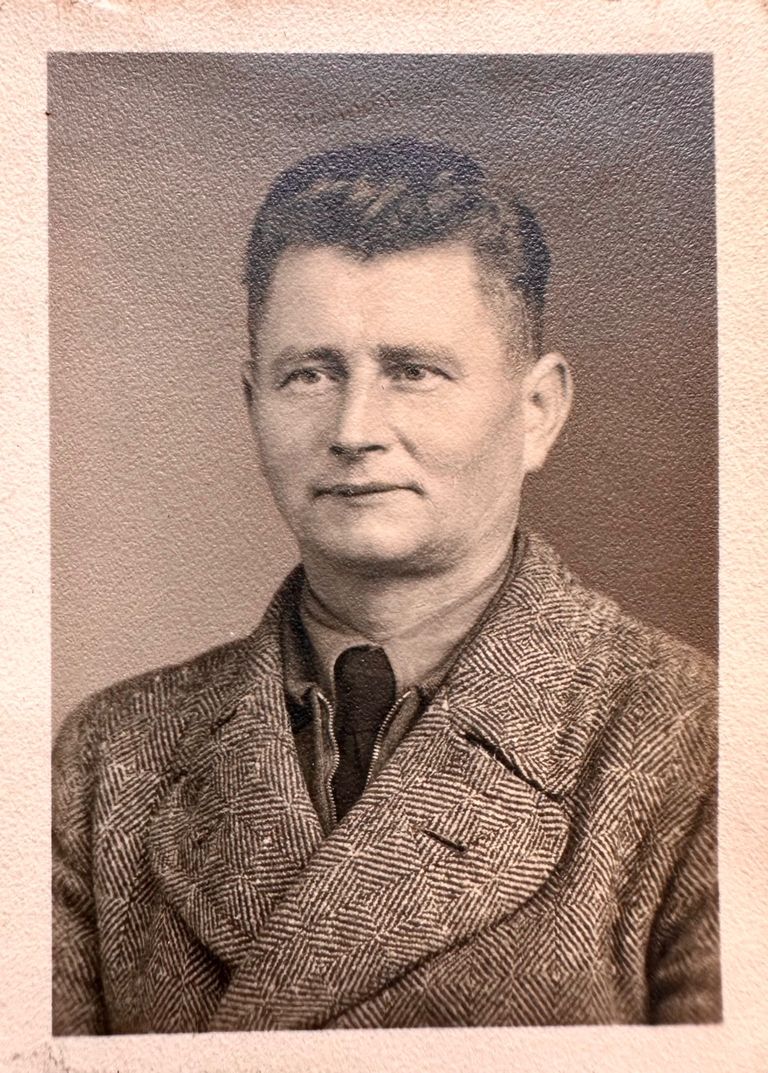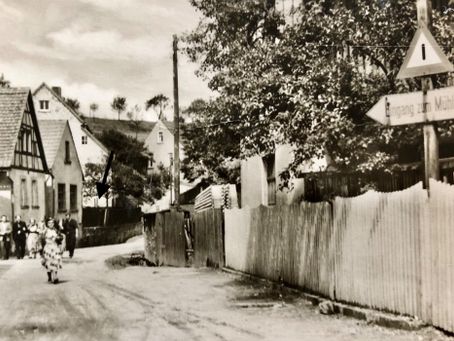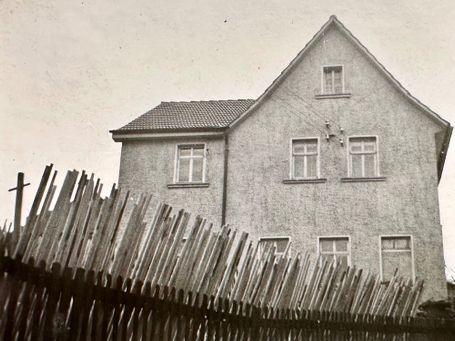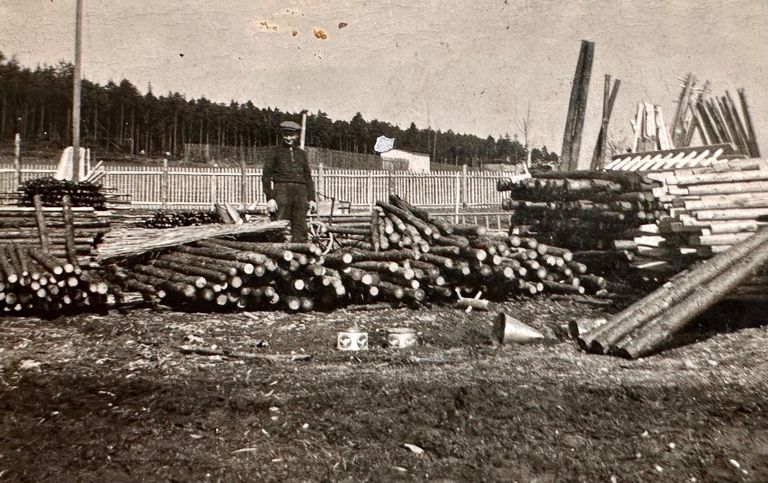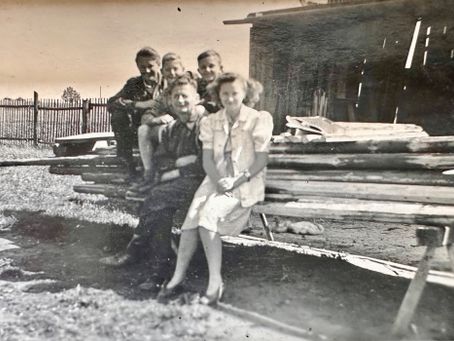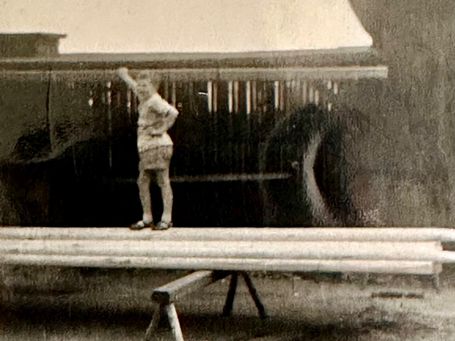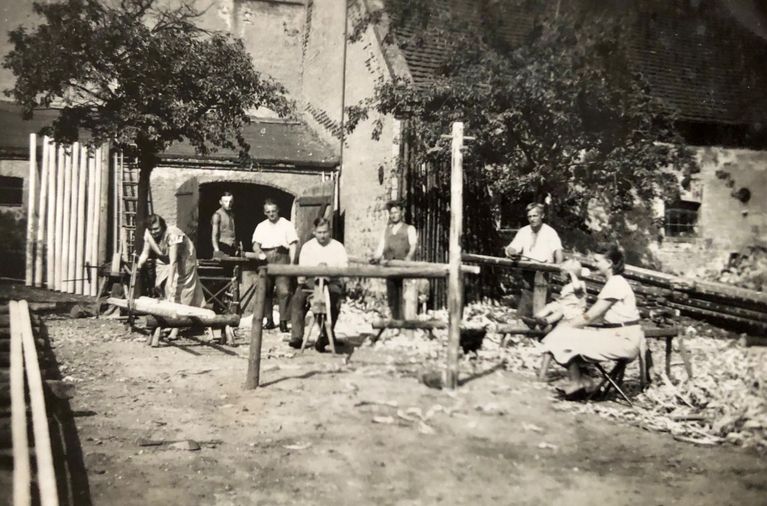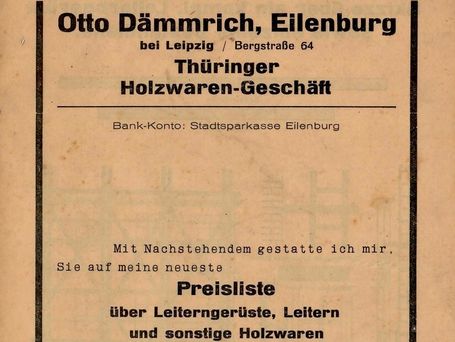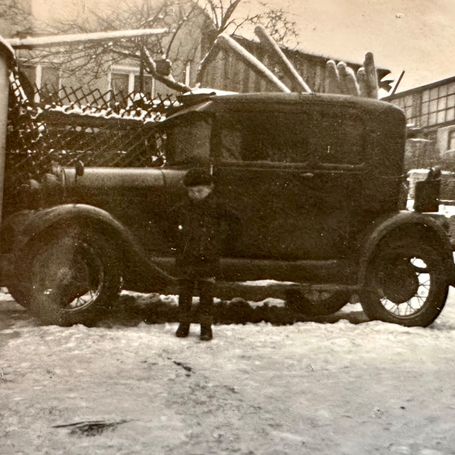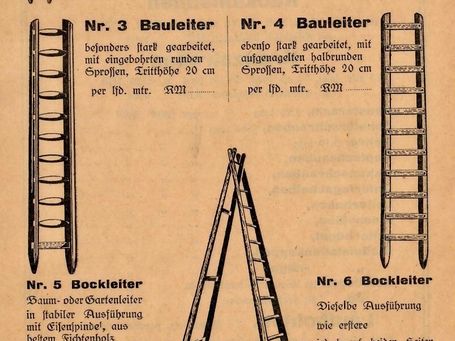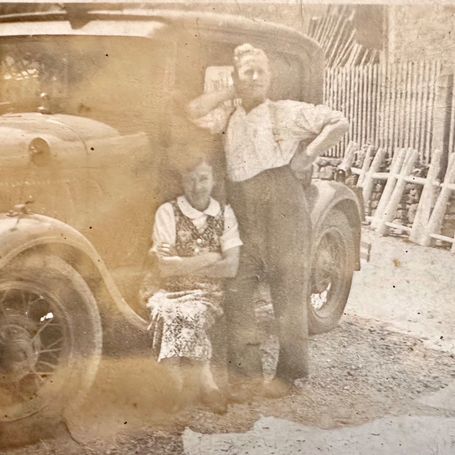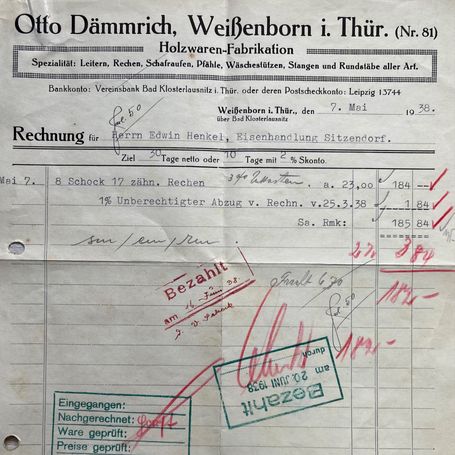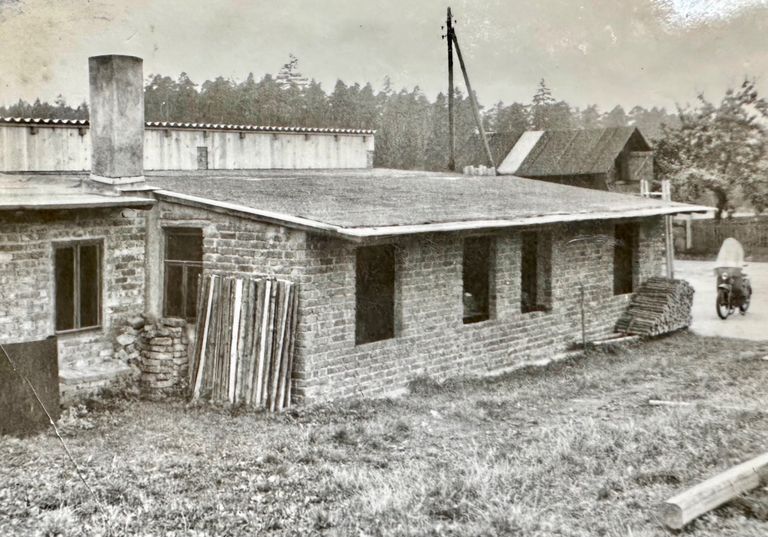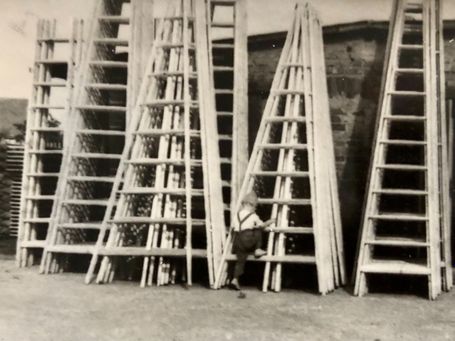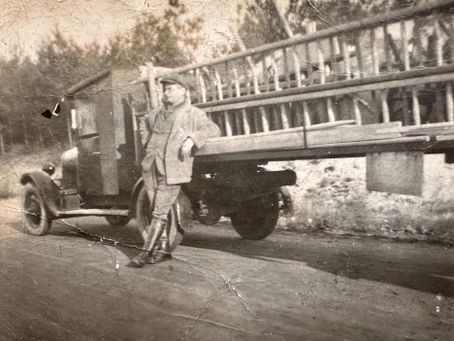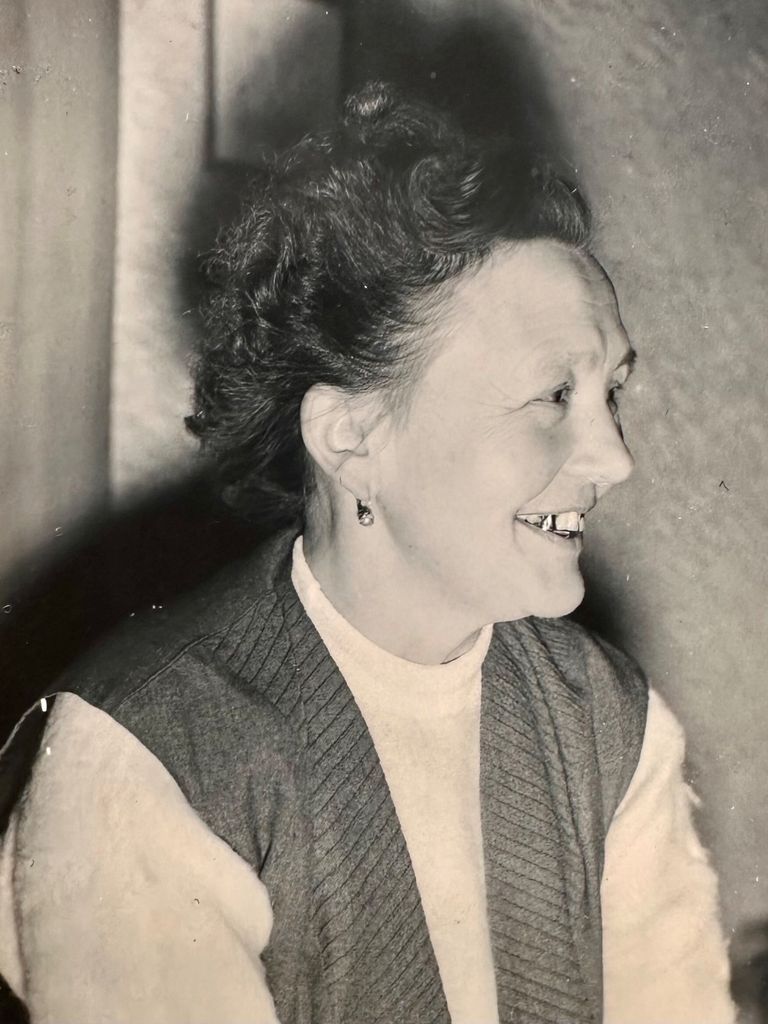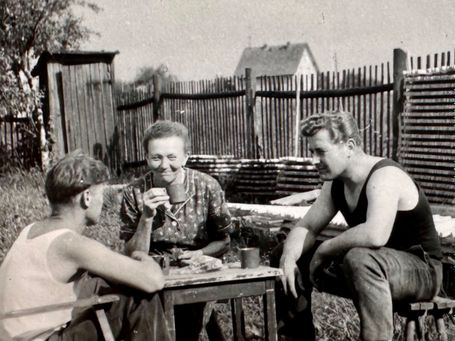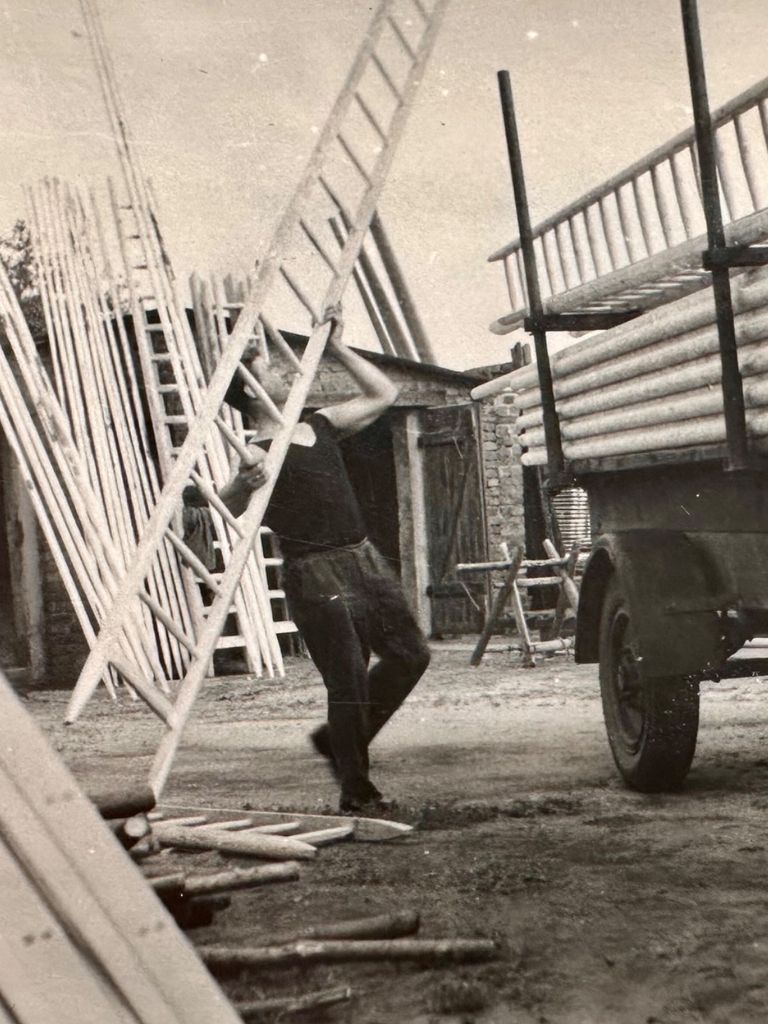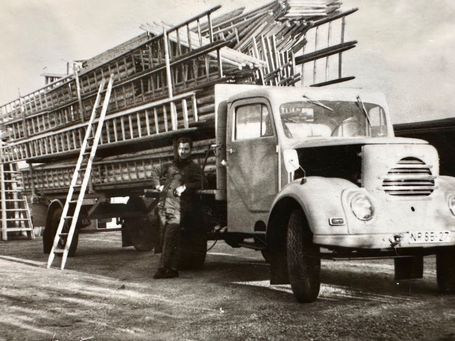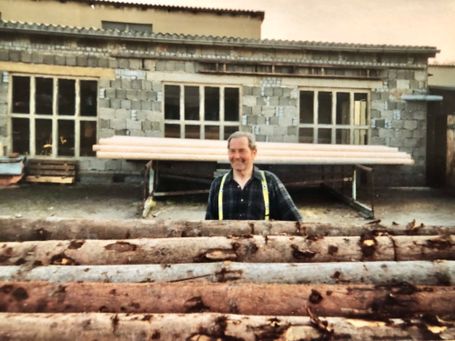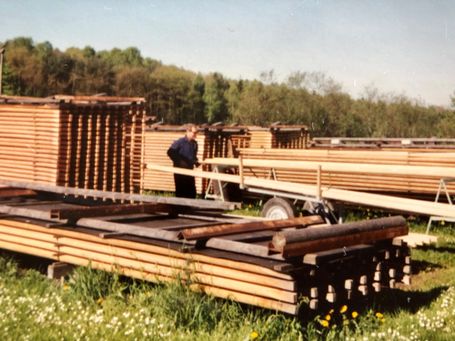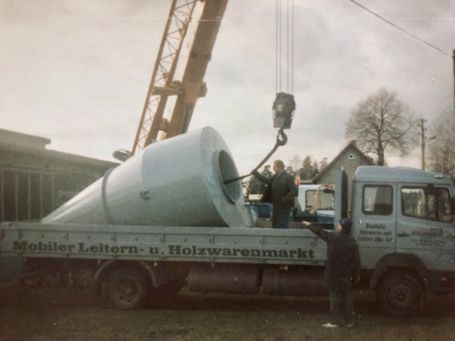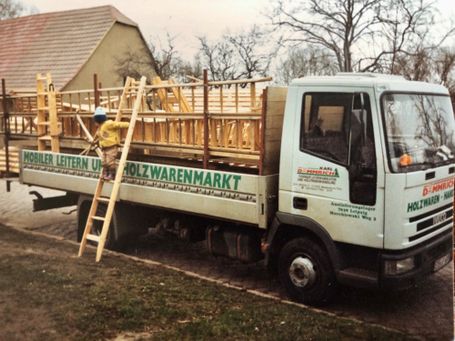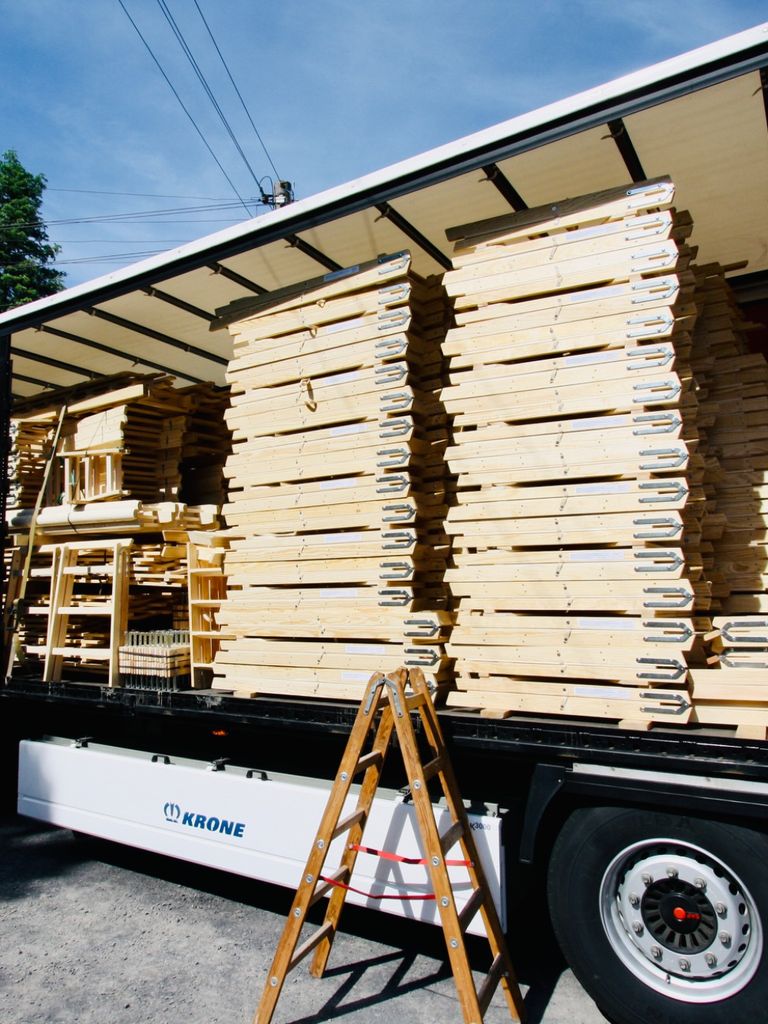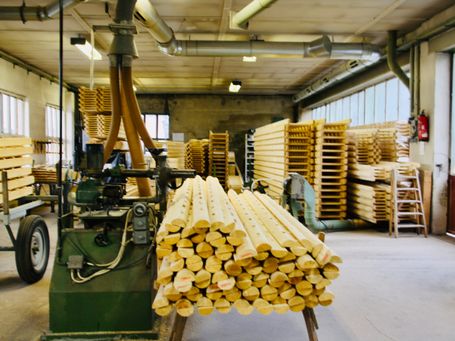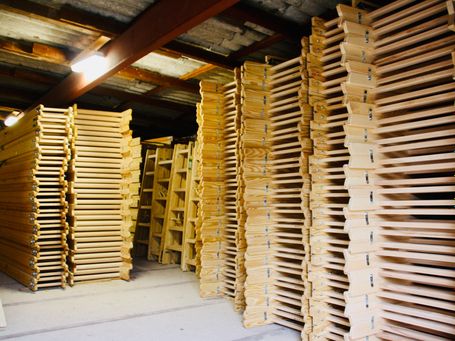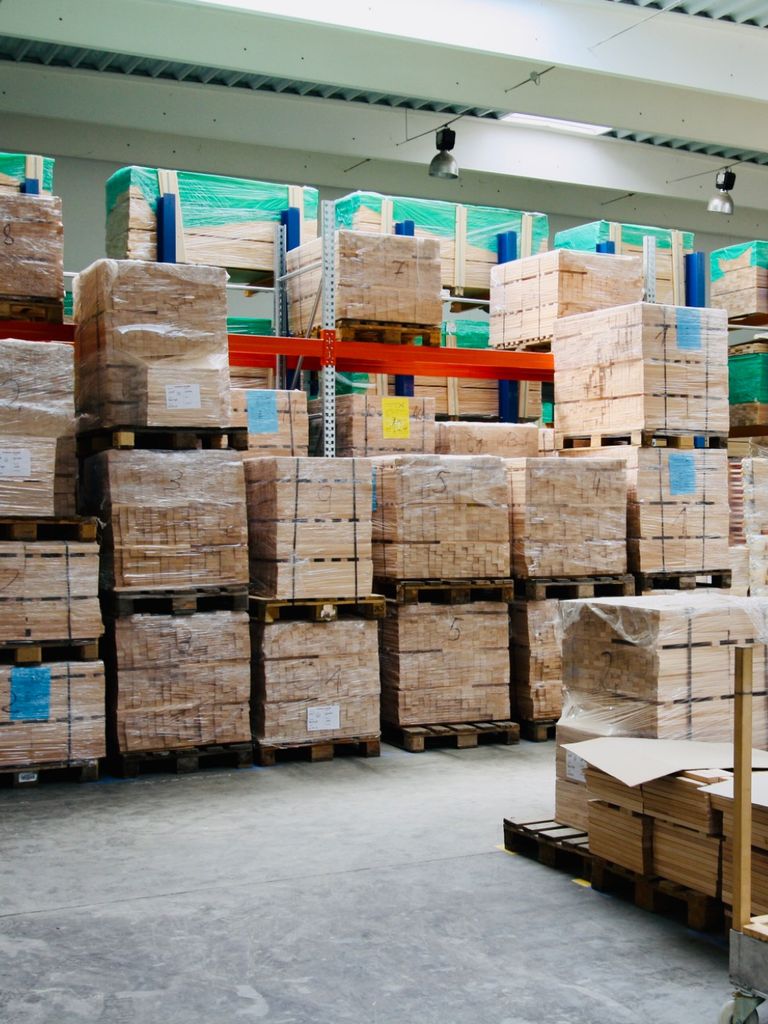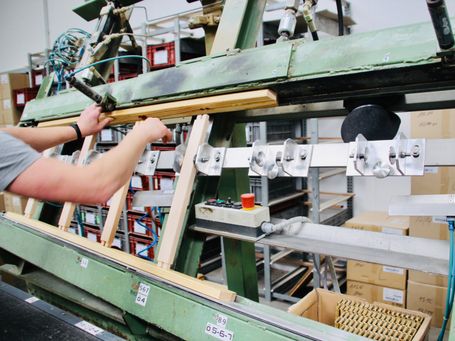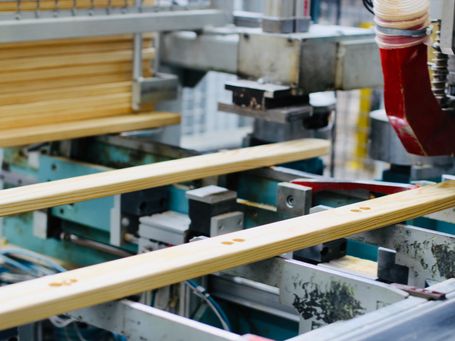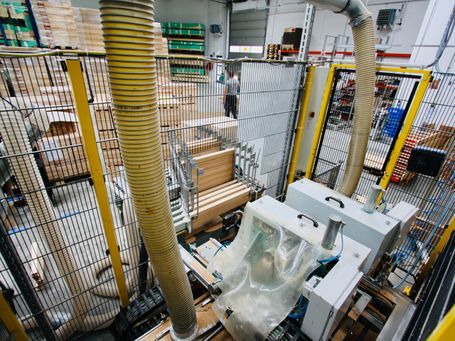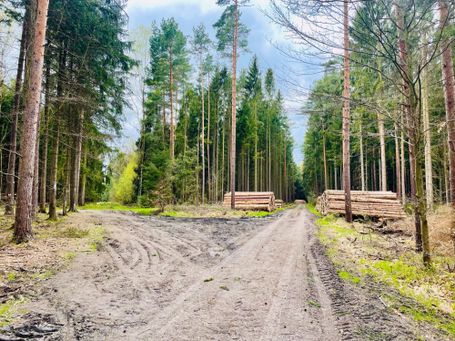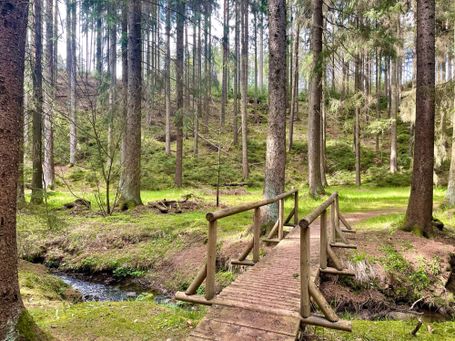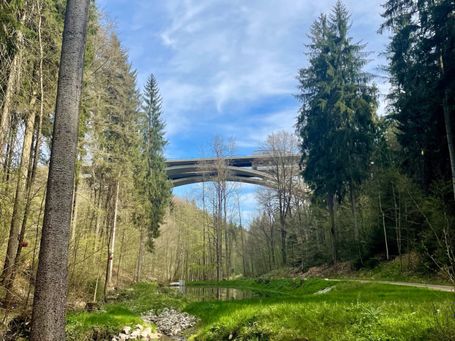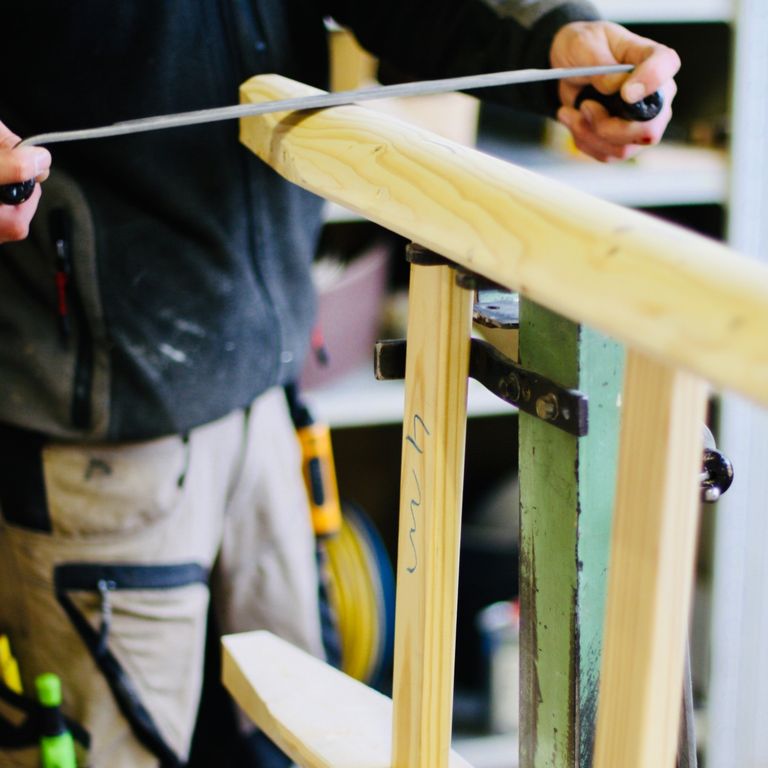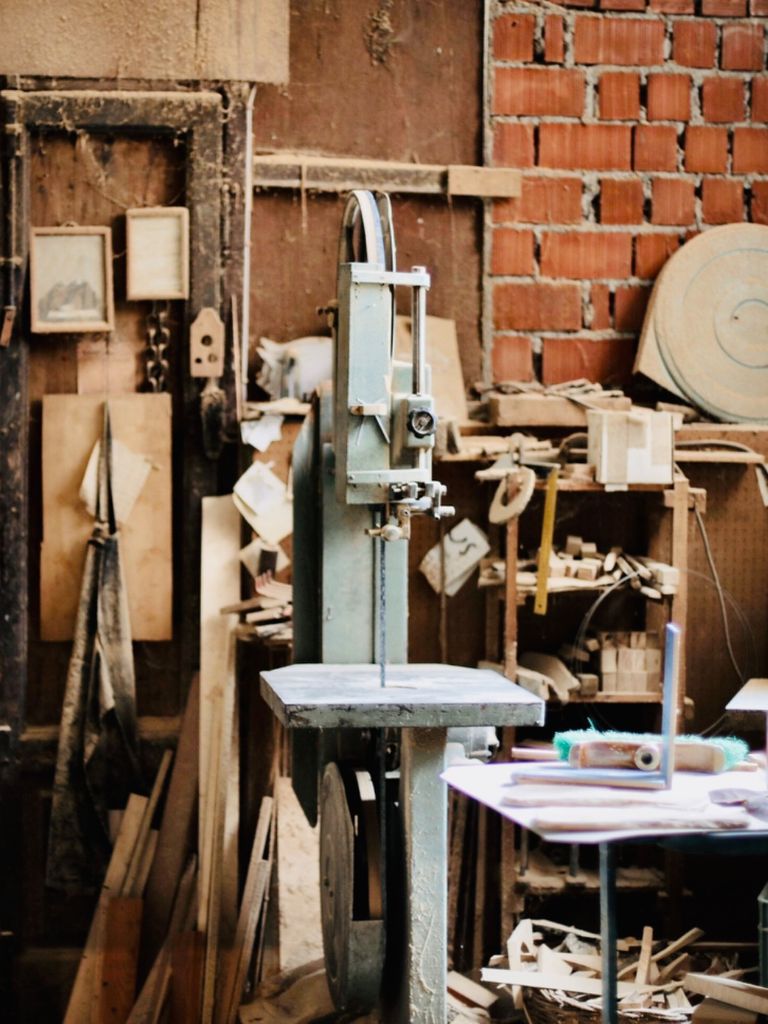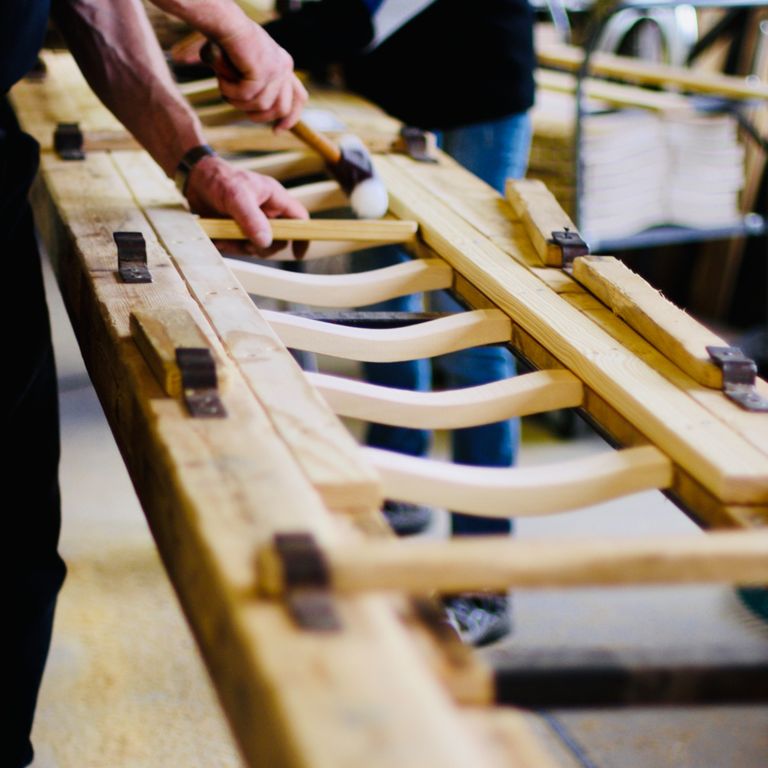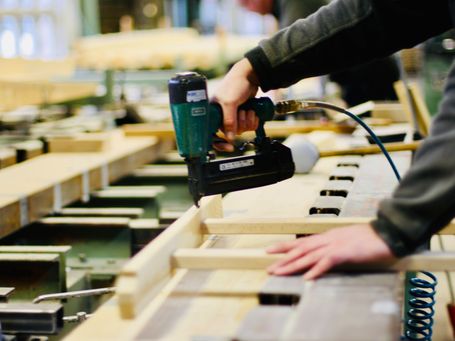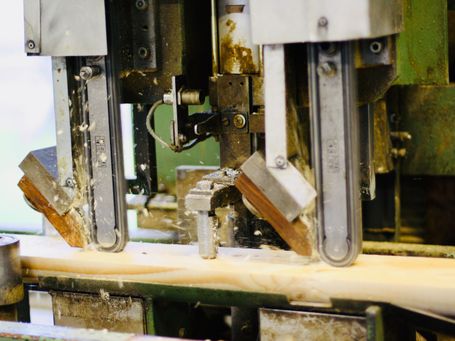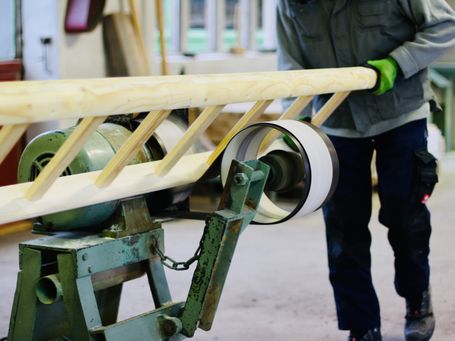Company chronicle
In April 1925, Otto Dämmrich founded the company at the entrance to the Weißenborner Mühltal as “Otto Dämmrich, Holzwaren-Fabrikation”.
The company's almost 100-year history begins with the production of wooden rakes and wooden trestles. There is also a flourishing trade in wooden goods of all kinds, such as laundry poles, laundry racks, sheep racks, baking troughs...all goods are produced in Weißenborn and the surrounding communities, the “Thuringian Woodland”.
At the beginning of the 1930s, production moved from the workshop at the house to an allocated field plot on what later became Karl-Liebknecht-Straße and today's Eisenberger Straße.
At this time, Otto Dämmrich began producing wooden rung ladders for the first time - initially in the open air.
In addition to delivering to commercial customers and dealers, Otto Dämmrich also travels “to the trade” via the villages in the area around Leipzig / Halle to just before Berlin in order to sell his goods there.
For this reason, in the early 1930s he opened the “Thüringer Holzwaren-Geschäft” in Eilenburg, Bergstrasse 64, where he lived with his wife and three sons until shortly before the outbreak of war.
After returning from the war in 1948, Otto Dämmrich began to build up the business a second time, because the board workshop and all the materials were destroyed by aircraft fire. A brick workshop is gradually being built. A Mercedes truck is purchased for the mobile trade, which has a special structure for ladders.
The start for the successor is difficult. The planned economy in the GDR is managed and controlled by the state. The needs of the national economy, like trade, are determined by a central authority. For Karl Dämmrich, this means that he is only allowed to sell the ladders he produces to private customers and not to companies. In addition, due to the scarcity economy, many things are subject to quotas, including wood and fuel for companies.
Socialist companies, like private companies, are severely restricted in their entrepreneurial freedom. And as we all know, necessity is the mother of invention. Ways are being found to circumvent the socialist planned economy. The ladders are often paid for in kind.
In addition to these problems, Karl Dämmrich is concerned about the fear of expropriation. By 1972 there were still around 11,000 privately run companies in the GDR - a thorn in the side of the socialist government. In February 1972, the government under Erich Honecker initiated the second wave of nationalization.
But the family business was lucky and was spared - and the situation calmed down in the early 1980s.
In order to meet the increasing demand, production is being expanded, employees are being hired and new machines are being invested. You can't buy these machines, especially for wooden ladder production, in the GDR - that's why Karl Dämmrich has them built according to his own ideas, his own development and his own drawings. A difficult task in the former GDR - and it often takes several years from the idea to commissioning.
Karl Dämmrich runs the company “with heart and soul”, is the first in the morning, the last in the evening and prefers to have a hand in everything himself.
The company owner quickly realizes that this form of sales/distribution has no future in the market economy and begins to build up commercial customers - larger construction companies, construction retailers, painting companies and other resellers.
In 1995, the son Roger Dämmrich joined the family business and has been running the business as an independent entrepreneur since 2002 with the company name “Dämmrich Ladders”.
Further investments increase production volumes and the product range is expanded.
In addition to the conventional wooden single ladders, rung stepladders, folding trestles, roof ladders and special step ladders are now also manufactured for the European market.
In 2020, the company opened a second, partly automated production site and relocated the production of rung stepladders and folding trestles to the new workshop.
In 2021, the production facility will be expanded to include stepladders.
Dämmrich Ladders now employs 13 people in production and 2 employees in accounting and is one of the leading manufacturers of wooden ladders in Germany.

The Thuringian Woodland
The Thuringian Woodland is a hilly landscape in the east of Thuringia. The area is located on a barren sandstone slab, which means that the extensive forest areas have been preserved due to the lack of agriculture. These have always been used intensively for forestry purposes, but also serve as local recreation areas. The following communities belong to Holzland: Hermsdorf, Klosterlausnitz, Oberndorf, Reichenbach, Schleifreisen, St. Gangloff, Tautenhain and Weißenborn.
(Source: https://de.wikipedia.org/wiki/Thüringer_Holzland)
You can find out more about Woodland and the surrounding area as well as excursion, refreshment and overnight accommodation options from the tourism association using the link below.
The Ladder makers
„Goofd Leddern!“
The profession of ladder maker is unlikely to have emerged here before the 17th century. In any case, a ladder maker was first mentioned in the Klosterlausnitz church register in 1676. Bad Klosterlausnitz is one of eight villages in the city triangle Eisenberg, Stadtroda, Gera, which is known as Thuringian Holzland. In no other area of Germany were so many rake makers, sheep rack makers, cart makers, trough makers and ladder makers concentrated in the 18th and 19th centuries as here.
Schirrmacher was the collective term for these woodworking professions.
Where agriculture was not profitable enough, people in the villages looked for additional sources of income.
They used the forest and manufactured various everyday items. Until the end of the last century, around two thirds of the inhabitants of the Holzland villages earned their living from making and selling wooden objects and other forest products.
Weißenborn became the center of rung ladder production...
from “Regional Studies of the Duchy of Saxony-Altenburg: Wood was piled up in front of every house. Trunks, sticks, blocks, logs or brushwood, in the yards, barns and sometimes also in the rooms, the men were busy making all kinds of equipment from this wood, such as brooms, shingles, roofing chips, goods boards, laundry racks, rakes, ladders“.
The ladder makers usually specialize. At the beginning there were only rung ladder makers and from around 1890 there were scaffold ladder makers. In 1927 Weißenborn had 56 ladder makers.
Today there are only a few ladder makers left in the Thuringian Woodland, mostly in the third or fourth generation.
Some of the ladders are still made by hand.
But progress has also made its way into this industry and the ladders are predominantly produced mechanically/industrially.
The activity of a wooden ladder maker is still not a recognized craft profession, but rather represents a trade similar to a craft, which can be carried out independently without any special qualifications, such as a master craftsman or journeyman examination.
(Source: https://berufe-dieser-welt.de/leitermacher/)
Wir benötigen Ihre Zustimmung zum Laden der Übersetzungen
Wir nutzen einen Drittanbieter-Service, um den Inhalt der Website zu übersetzen, der möglicherweise Daten über Ihre Aktivitäten sammelt. Bitte prüfen Sie die Details und akzeptieren Sie den Dienst, um die Übersetzungen zu sehen.

